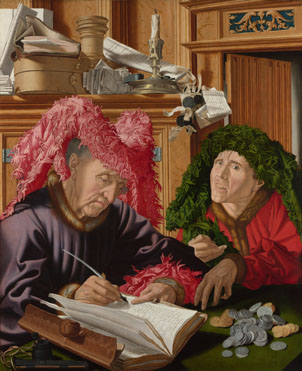Continuing our series looking at great paintings housed in London’s National Gallery…
Dating from around 1540, this arresting painting depicts an unlovely pair of taxmen, evidently just as popular in 16th century Zeeland (in the Netherlands) as they are everywhere today.
It is agreed to be unlikely that Marinus painted from a real scene: the costumes are ludicrous and the details improbable (the pot containing ink-blotting sand stands on the shelf rather than handily on the table). Instead, it is a satire on covetousness.
The chap on the left, with more than a hint of the Wicked Witch of the West about him, is compiling a list of municipal revenues from imposts on produce (wine, beer and fish are legible) in the town of Reymerswaele, from whence the artist hails.
The one on the right, who could be played by Paul Whitehouse, gropes like Gollum towards the viewer, his face distorted in what looks like a sort of permanently deforming pain. Perhaps it prefigures the eternal torment that awaits him beyond the grave, for his unforgivable sin of collecting monies on behalf of the state and enjoying it.
I like Two Tax Gatherers for the same reason I like Massys’ grotesque Old Woman and Bruegel’s Adoration of the Kings: because I am drawn to well-made ugliness as much as beauty. There’s an uncanny, hyper-real clarity about it that reminds me of Kit Williams’ Masquerade – a book which I would study at length as a child because it was mysterious and disturbing. Several times I have found myself standing in front of Two Tax Gatherers, looking in vain for an elusive hare amongst the papers and candlesticks.









I have an astounding theory about great classical artists. They are all turned on by painting folded cloth. So, Flora pet, it wasn’t your mush old Sandro was interested in, it was the folds in three graces knickers, Primavera my foot, the dastardly Itie had a fold fetish.
Could we then be accused of foldfetishism I ponder.
That is pretty astounding, Malty. Well worth investigating I’d say. See if you can get a grant.
Malty, Tom Sutcliffe had an interesting piece on just this topic in the Independent last year.
http://www.independent.co.uk/opinion/columnists/thomas-sutcliffe/tom-sutcliffe-renaissance-artists-had–the-hang-of-it-1958034.html
Sutcliffe seems to be arguing that the depiction of draped cloth with all its ripples, drifts, lumps, billowings, sags, wafts, dimplings, and dilations is somehow at the heart of this funny business of translating three dimensions into two. In Renaissance art “the mastery of drapery was a standard element of every artistic apprenticeship. Learning how to control the interplay of highlight and shadow, of sharply defined curves and folds and soft bulges was … a starting point for any artist who wanted to acquire a basic vocabulary of light and shade and volume.”
He goes on to argue that nailing the folds, pleats, clumps, and interwrinkled slippery bits could be crucial to the success of religious or mythological paintings in particular. According to Sutcliffe, the handling of drapery is “the most tangible expression of representational realism – a bit of the painting that we can almost feel on our skin”: this means that in fantastic or allegorical art getting it right becomes critical — “the vividness of its depiction must sometimes stand as an affidavit for the accuracy of more speculative inventions.”
I suppose you had to do something to kill the time before they invented iPads.
Thanks for that link jonathan, interesting read, kind of Independent verification of the astonishing theory.
The apparent obsession is not just in painting, the Casa Buonarroti’s star turn is a Michelangelo relief, The Madonna of the Stairs, sculpted when he was a teenager and has the central figure seated on a plinth, the detailing of the folded cloak draped over the plinth is amazing, there is more fold than figure.
The museums real show stopper however has no distracting folds, his pencil drawing of Cleopatra is utterly sublime.
I think the chap on the right could be played by Michael Crawford or Lee Evans, and he is, as you say, the very definition of ‘grasping’
I really like it as a picture, it has a lot of life and character in it
I learn from Wikipedia that it was left to the National Gallery by a silk merchant and politician, Wynne Ellis, who, a nineteenth-century liberal, opposed the Corn Laws and supported free trade more generally. As the subjects are calculating tax on luxuries, foodstuffs, etc. it surely struck a chord with him!
They’ve obviously lavished their receipts on extravagant head-gear. Bet their pensions were pretty good too.